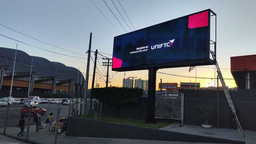Hands Off: Emerging Trends in Touchless Technology

Have you ever asked a smart speaker to play a song or look up a recipe with your voice? If so, you may already be ahead of the curve. Touchless technology is growing exponentially as workers slowly transition back to the office. Though it was already on the rise before, COVID-19 accelerated it.
Consider the benefits of touchless technology when choosing return-to-work essentials. They're not limited to hygiene and safety as they can be used to improve customer engagement, streamline an organization's processes, and create immersive environments when used with digital signage and conferencing and collaboration tech.
Before the Coronavirus pandemic hit, many conference rooms used technology with multiple touchpoints, but reducing common touchpoints helps to slow the spread of germs. And if the last two years have taught us anything, it is the importance of adaptability.
COVID-19 has created a surge in demand for contactless commerce. Early in the pandemic, people were advised to touch as little as possible. Companies scrambled to make changes. People began by having less contact with equipment, surfaces, and handles. Practically every industry shifted to its business operations and adopted novel technologies to reduce physical contact.
Director of Software Development at Neonode Karl-Johan Svennenfors shared his thoughts: “Contactless touch technology is the perfect answer to keeping people safe in all workplace settings, rapidly reducing anxiety levels and encouraging people back into the office. They provide precise and accurate means to interact with any electronic device or surface without physical contact. Fast and easy to deploy, they can be retrofitted to an organization’s existing infrastructure using easy-to-install touch sensor modules.”
Infrared lasers are the secret sauce of Neonode's contactless touch solutions. They work by casting a sheet of light either above or in front of a display or surface and creating touch interaction on an in-air display.
In addition to touchless check-ins for employees and visitors, some companies have started using no-contact sign-in apps and employee QR codes, among other methods, to improve their processes.
Here are a few of the most cutting-edge touchless technologies:
- Radio-frequency identification (RFID) and near-field communication (NFC): Some of the most conventional technologies enabling touchless interfaces. Both depend on radio-frequency signals to swap data between devices. Digital signage makes use of this in a variety of settings.
- Gesture recognition: Another popular form of touchless technology is gesture recognition. With simple gestures, users can interact with devices without physically touching them. Despite the higher price tag of this advanced motion-sensing, it is expected to become more prevalent in workplaces and businesses with ultra-high safety standards, such as manufacturing plants and hospitals. Gesture recognition technology will likely become increasingly widespread in corporate offices and other public locations where staff and consumers interact with public computers and shared utilities, such as elevators, ticket machines, and even coffee makers.
- Touchless sensing: In touchless sensing, a person can be detected or tracked under a sensor. It is becoming increasingly common nowadays, just like gesture recognition. Sensors are among the most affordable touchless workplace technologies. As a result, it is expected that more and more businesses will use motion sensors for a safe work environment and customer experience.
- Voice activation: Using voice recognition software, users can perform tasks through their voices. Apple's Siri, Google's Home, or Amazon's Alexa are a few examples of this. Some smaller companies have developed voice recognition technology for public and business applications, such as voice-activated ATMs and train ticketing machines. Through smart and touch-free, voice-activated products, businesses can reduce typing time, eliminate the need to keep manual records and let users add items verbally into their calendars.
- Bluetooth: By detecting an encrypted Bluetooth low-energy signal, a reader connects a mobile app with an existing sensor and system to enable this technology to work. Again, think of digital signage that can interact with viewers via their smart phone.
- QR codes/barcodes: With mobile quick response codes (QR codes), users can access information instantly. QR codes are a version of a barcode. They are an open-source technology that can direct users to download apps or visit a particular website when scanned.
- Biometric authentication: Biometrics verify a person's identity using physical characteristics (e.g., a face or palm).
Shiraz Kapadia, CEO and President of Invixium, one of the world's leading biometrics developers, agrees with Svennenfors and spoke about the benefits of implementing touchless technologies.
“Many of these technologies are based on machine learning or AI because they require accurate matching and data analysis, which improve biometrics’ accuracy, functionality, and adaptiveness to respond to the pace at which our world is changing,” says Kapadia. “In reality, there is a high percentage of work that cannot be performed at home. [For employers, this is an] added responsibility to address employees' health and safety concerns who are required to come into the worksite. While advancements in biometrics due to economies of scale are helping costs go down, the real question is about return on investment (ROI). Yes, plastic access cards are cheaper to buy, but they cannot prevent a shutdown in the same way that touchless biometrics and wellness screening can.”
As the use of touchless technology grows, research will focus on improving sensors, processing systems, and other aspects of the user experience. This is a relatively new technology being implemented on a wide scale. Some may find it challenging at first, but it will revolutionize the way we work, play, and live in the long run.






Please sign in or register for FREE
If you are a registered user on AVIXA Xchange, please sign in
The demonstrations I've seen in biometric user identification are stunning - straight out of Star Trek and Minority Report.